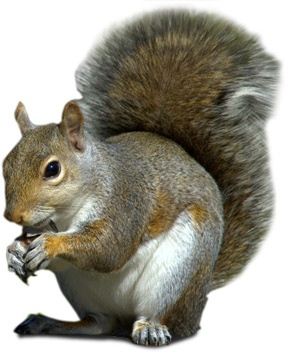Squirrel control

Gery Squirrel Sciurus carolinensis is a medium sized tree squirrel (8 to 10 inches long with a bushy, 6 to 8 inch long tail, weighing 500 to 600 grams). There is no difference in size or coloration between males and females. Coloration ranges from dark to pale grey body with white to pale grey underbelly and tail. More black-coated Grey Squirrels occur in the north. Grey Squirrels are highly adapted for climbing trees – they have tough curved claws, and the ability to reverse their hind foot 180 degrees to permit headfirst descent. Grey squirrels are excellent climbers and can leap considerable distances using powerful hind limbs. Tails are used for balance when running and leaping between trees, and held over the back of a resting animal.
The squirrel’s ability to store food is a evolutionary measure to insure it’s survival. Having a surplus of food when Mast numbers are low due to productivity cycles or during winter months is obviously beneficial. Usually, the stored food is used within a year’s time. Hoarding occurs in on of two ways. Scatter hoarding is dispersing single nuts in separate areas (common in grey squirrels). Larder hoarding is caching a quantity of food at a single sight (common is red squirrels). Larder hoards are usually made close to the squirrel’s nest. Recovery rates for scatter hoard are 50%-60%.
Nests & Territory
Nests for grey squirrels are usually made of leaves (called dreys) in the summer months and in the winter months nests are located in tree cavities (called dens). Squirrels use more than one active den and the average number is three dens for each squirrel. It takes one day for a squirrel to make a leaf nest and the inside diameter is 6-8 inches. It is not uncommon for squirrels to share nests, especially in winter months. Grey squirrel uses approximately 1.5 acres as a home territory and this area can be shared with other squirrels. They can range up to 5 miles from the nest.
Reproduction
Reproduction rates of squirrels are related to availability of food. In years when mast production is low, there will be few or no litters. On the other hand, during times when mast production is high, squirrels will produce 2 litters each year. The average litter size is 3. Weaning occurs between 8-10 weeks.

Squirrels in the attic is the most common reason we’re called upon for our squirrel removal services.
For best squirrel control practice, remove any open diet sources: seeds, nuts, and fruits are all prime targets for squirrels in the house. Gutter guards can keep squirrels from finding entry points into your home. If a squirrel has chewed its way into your home or attic, exclusion is the preferred method of squirrel removal. This is best left to wildlife control services to exclude these animals in a safe and humane way.



